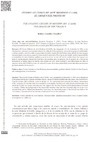Please use this identifier to cite or link to this item:
https://accedacris.ulpgc.es/jspui/handle/10553/114245
| Title: | Centro Atlántico de Arte Moderno (CAAM). El origen del proyecto | Other Titles: | The atlantic center of modern art (CAAM). The origin of the project | Authors: | González González, Idalmy | UNESCO Clasification: | 6203 Teoría, análisis y crítica de las bellas artes 510106 Museología |
Keywords: | Centro Atlántico de Arte Moderno CAAM Tricontinentalidad Política cultural Cabildo de Gran Canaria, et al |
Issue Date: | 2021 | Publisher: | Cabildo Insular de Gran Canaria | Conference: | XXIV Coloquio de Historia Canario-Americana | Abstract: | El Centro Atlántico de Arte Moderno (CAAM), fue inaugurado el 4 de diciembre de 1989, como culminación al proyecto que comenzó a finales de la década de los setenta de la mano de un grupo de intelectuales y artistas canarios, entre los cuáles se encontraba el escultor canario Martín Chirino quien, además de tener un gran reconocimiento como artista, aceptó la dirección de la institución. Para iniciar este estudio resulta imprescindible contextualizar el marco histórico, político y social en el cual se creó el CAAM y cuáles fueron los apoyos que desde la administración autonómica facilitaron las acciones para su creación. En el contexto de la transición democrática se habían puesto en marcha otros centros de arte a nivel nacional y para diferenciarse de ellos, el proyecto teórico del CAAM se construyó sobre el discurso de la tricontinentalidad, convertido desde entonces en eje fundamental de la institución. The Atlantic Center of Modern Art (CAAM), was inaugurated on December 4, 1989, as a culmination of the project that began in the late seventies due to a group of Canarian intellectuals and artists, among which was Canarian sculptor Martín Chirino whom in addition to be a recognized artist accepted the cultural management of the institution. To start this study it is essential to contextualize the historical, political and social framework in which the CAAM was created and what were the supports that the Gran Canaria island administration favorised its creation. Within the background of the democratic transition they had been launched other art centers at a national level, and to differentiate themselves from them, the theoretical project of the CAAM was built on the tricontinental discourse which has become a fundamental axis of the institution. |
URI: | https://accedacris.ulpgc.es/handle/10553/114245 | ISSN: | 2386-6837 | Source: | XXIV Coloquio de Historia Canario-Americana [ISSN 2386-6837] |
| Appears in Collections: | Actas de congresos |
Page view(s)
185
checked on Mar 1, 2025
Download(s)
93
checked on Mar 1, 2025
Google ScholarTM
Check
Share
Export metadata
Items in accedaCRIS are protected by copyright, with all rights reserved, unless otherwise indicated.
